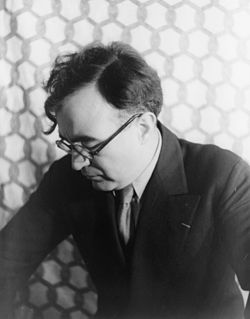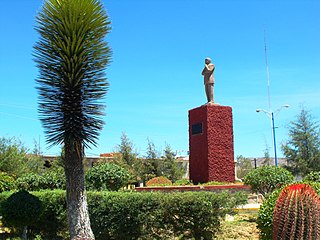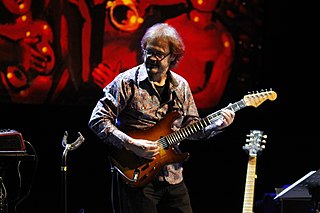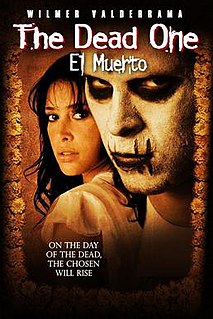
Juan García Esquivel, often simply known as Esquivel!, was a Mexican band leader, pianist, and composer for television and films. He is recognized today as one of the foremost exponents of a sophisticated style of largely instrumental music that combines elements of lounge music and jazz with Latin flavors. Esquivel is sometimes called "The King of Space Age Pop" and "The Busby Berkeley of Cocktail Music." Esquivel is considered one of the foremost exponents of a style of late 1950s-early 1960s quirky instrumental pop that became known as "Space Age Bachelor Pad Music".

Musical composition, or simply composition, can refer to an original piece or work of music, either vocal or instrumental, the structure of a musical piece, or to the process of creating or writing a new piece of music. People who create new compositions are called composers. Composers of primarily songs are usually called songwriters; with songs, the person who writes lyrics for a song is the lyricist. In many cultures, including Western classical music, the act of composing typically includes the creation of music notation, such as a sheet music "score," which is then performed by the composer or by other instrumental musicians or singers. In popular music and traditional music, songwriting may involve the creation of a basic outline of the song, called the lead sheet, which sets out the melody, lyrics and chord progression. In classical music, orchestration is typically done by the composer, but in musical theatre and in pop music, songwriters may hire an arranger to do the orchestration. In some cases, a pop or traditional songwriter may not use written notation at all, and instead compose the song in their mind and then play, sing and/or record it from memory. In jazz and popular music, notable sound recordings by influential performers are given the weight that written or printed scores play in classical music.
The music of Cuba, including its instruments, performance and dance, comprises a large set of unique traditions influenced mostly by west African and European music. Due to the syncretic nature of most of its genres, Cuban music is often considered one of the richest and most influential regional musics of the world. For instance, the son cubano merges an adapted Spanish guitar (tres), melody, harmony, and lyrical traditions with Afro-Cuban percussion and rhythms. Almost nothing remains of the original native traditions, since the native population was exterminated in the 16th century.
The music of Argentina includes a variety of traditional, classical and popular genres. One of the country's most significant cultural contributions is the tango, which originated in Buenos Aires and its surroundings during the end of the 19th century and underwent profound changes throughout the 20th century. Folk music was particularly popular during the 20th century, experiencing a "boom" in popularity during the 1950s and 1960s thanks to artists such as Atahualpa Yupanqui and Mercedes Sosa, prominent figures of the Nuevo cancionero movement. In the mid-to-late 1960s, the countercultural scene of Buenos Aires originated Argentine rock, considered the earliest incarnation of Spanish-language rock for having an autochthonous identity that differed from that of England or the United States. It was widely embraced by the youth and since then has become part of the country's musical identity as much as traditional music. According to the Harvard Dictionary of Music, Argentina also "has one of the richest art music traditions and perhaps the most active contemporary musical life.

The music of Mexico is very diverse and features a wide range of musical genres and performance styles. It has been influenced by a variety of cultures, most notably the culture of the indigenous peoples of Mexico and Europe. Music was an expression of Mexican nationalism, beginning in the nineteenth century.
Music of Nicaragua is a mixture of indigenous and European, especially Spanish, influences. Musical instruments include the marimba and others that are common across Central America. Pop music includes Cuban, Brazilian, Mexican and Panamanian performers, as well as those from Europe and the United States.
The music of Guatemala is diverse. Music is played all over the country. Towns also have wind and percussion bands that play during the lent and Easter-week processions as well as on other occasions. The Garifuna people of Afro-Caribbean descent, who are spread thinly on the northeastern Caribbean coast, have their own distinct varieties of popular and folk music. Cumbia, from the Colombian variety, is also very popular. Dozens of Rock bands have emerged in the last two decades, making rock music quite popular among young people.

Carlos Antonio de Padua Chávez y Ramírez was a Mexican composer, conductor, music theorist, educator, journalist, and founder and director of the Mexican Symphonic Orchestra. He was influenced by native Mexican cultures. Of his six symphonies, the second, or Sinfonía india, which uses native Yaqui percussion instruments, is probably the most popular.
New Mexico is a state of the Southwest United States. The state has music traditions dating back to the ancient Anasazi and Pueblo people, Navajo, Apache, and the Spanish Santa Fe de Nuevo México; these old traditions are found in both their original folk forms and as a modern folk genre known as New Mexico music. In the 1940s town of Clovis was home to the Norman Petty Studios, where Buddy Holly, Roy Orbison, and Waylon Jennings recorded. Perhaps the first well-known group hailing from New Mexico was The Fireballs scoring a #1 Hot 100 hit in 1963 called "Sugar Shack". Native American rock group Xit were signed and recorded Plight of the Redman (1972) and Silent Warrior (1973) for a subsidiary of Motown Records, Rare Earth Records. During the 1970s and 80s, New Mexico musicians Al Hurricane and Al Hurricane, Jr. became recognized on the nationally syndicated Val De La O Show.

Alfredo da Rocha Viana, Jr., better known as Pixinguinha was a composer, arranger, flautist and saxophonist born in Rio de Janeiro. Pixinguinha is considered one of the greatest Brazilian composers of popular music, particularly within the genre of music known as choro. By integrating the music of the older choro composers of the 19th century with contemporary jazz-like harmonies, Afro-Brazilian rhythms, and sophisticated arrangements, he introduced choro to a new audience and helped to popularize it as a uniquely Brazilian genre. He was also one of the first Brazilian musicians and composers to take advantage of the new professional opportunities offered to musicians by the new technologies of radio broadcasting and studio recording. Pixinguinha composed dozens of choros, including some of the most well-known works in the genre such as "Carinhoso", "Glória", "Lamento" and "Um a Zero".
José Pablo Moncayo García was a Mexican pianist, percussionist, music teacher, composer and conductor. "As composer, José Pablo Moncayo represents one of the most important legacies of the Mexican nationalism in art music, after Silvestre Revueltas and Carlos Chávez." He produced some of the masterworks that best symbolize the essence of the national aspirations and contradictions of Mexico in the 20th century.

Kimmo Pohjonen is a Finnish accordionist who is known for his avant-garde and experimental work with his custom-made electrified and modified instrument. He has released nine albums of his work and has toured Europe extensively, as well as performances in Japan and some in North America. He records and performs both solo and in collaboration with musicians and other artists, including the Kronos Quartet, and percussionist Pat Mastelotto and guitarist Trey Gunn of King Crimson. Pohjonen still lives in Finland when not on the road. He has performed with one of his daughters, Saana, who plays the drums.

Julián Carrillo Trujillo was a Mexican composer, conductor, violinist and music theorist, famous for developing a theory of microtonal music which he dubbed "The Thirteenth Sound".
Regional styles of Mexican music vary greatly vary from state to state. Norteño, banda, duranguense, Mexican Son music and other Mexican country music genres are often known as regional Mexican music because each state produces different musical sounds and lyrics.

Ensemble intercontemporain is a Paris-based, world-renowned ensemble of 31 full-time musicians dedicated to performing and promoting contemporary chamber music. It was founded by Pierre Boulez in 1972 for this purpose, the first permanent organization of its type in the world. Since then the Ensemble has toured extensively both in France and abroad, appearing especially at international festivals. Beyond performing they also have teaching and other outreach activities to support young musicians, composers and conductors.
Gabriela Lena Frank is an American pianist and composer of contemporary classical music.
Jorge Reyes was a Mexican ambient electronic musician who incorporated elements of his native Mexican culture into his music. He performed as the member of several groups and collaborations and as a solo artist.

Federico "Freddy" Ramos is a Uruguayan guitarist, arranger, producer and composer based in Santa Monica, California.
Armonicus Cuatro is a group of four vocalists from Mexico: Mario Iván Martínez, Lourdes Ambriz, Nurani Huet and Martín Luna which mostly specializes in European medieval, Renaissance and Baroque music. All four are established musicians in their own right, with Martínez also known as an actor in film and Mexican television. The group has performed widely in Mexico at music and cultural festivals such as the Festival Internacional Cervantino as well as in Europe.
The La Catrina Quartet is a group of four U.S.-based classical musicians who specialize in traditional and classical music from the Americas as well as traditional European pieces. The group was formed in 2001 by four graduate students at the Western Michigan University. The group tours regularly through the United States and Mexico, with about 50 performances per year at venues such as New Museum of Musical Instruments in Phoenix, the Symphony Space in New York and the Festival Internacional Cervantino. The quartet has collaborated with orchestras, composers and others to create new compositions, and record pieces by Latin American artists. In 2012, the group won a Latin Grammy for Best Classical Recording with Brasilero. It has also won the Research and Creative Scholarship Prize from the Western Michigan University and the Creative Scholarship and Arts Council Award of North Carolina.












